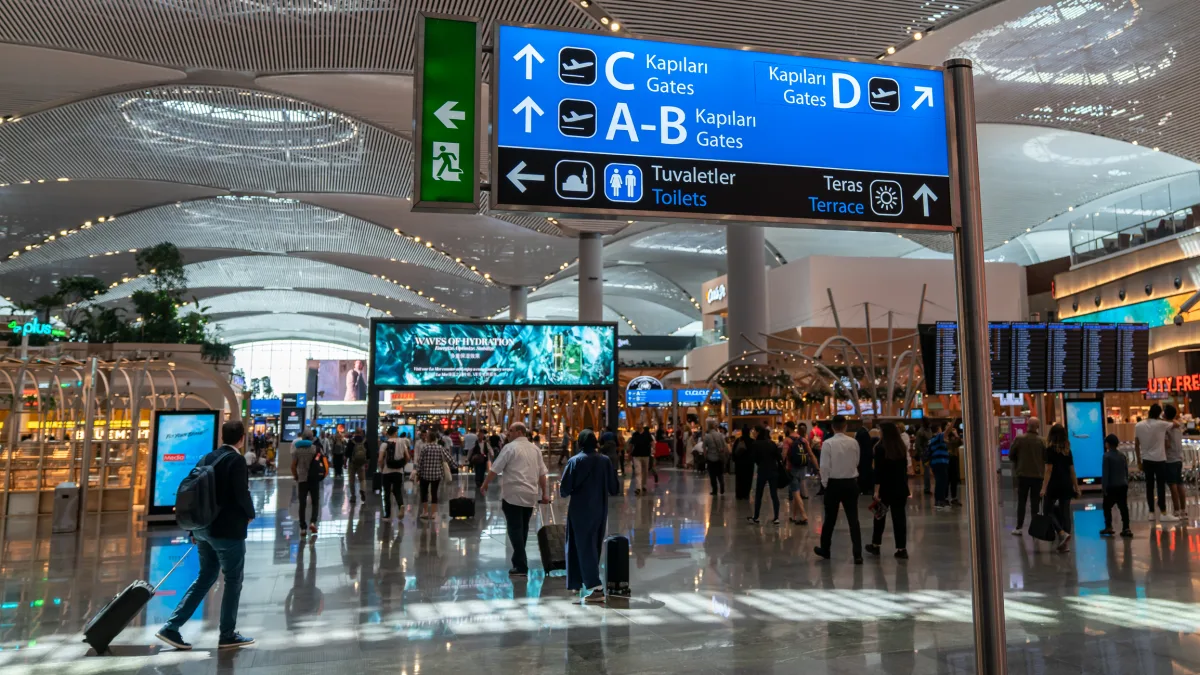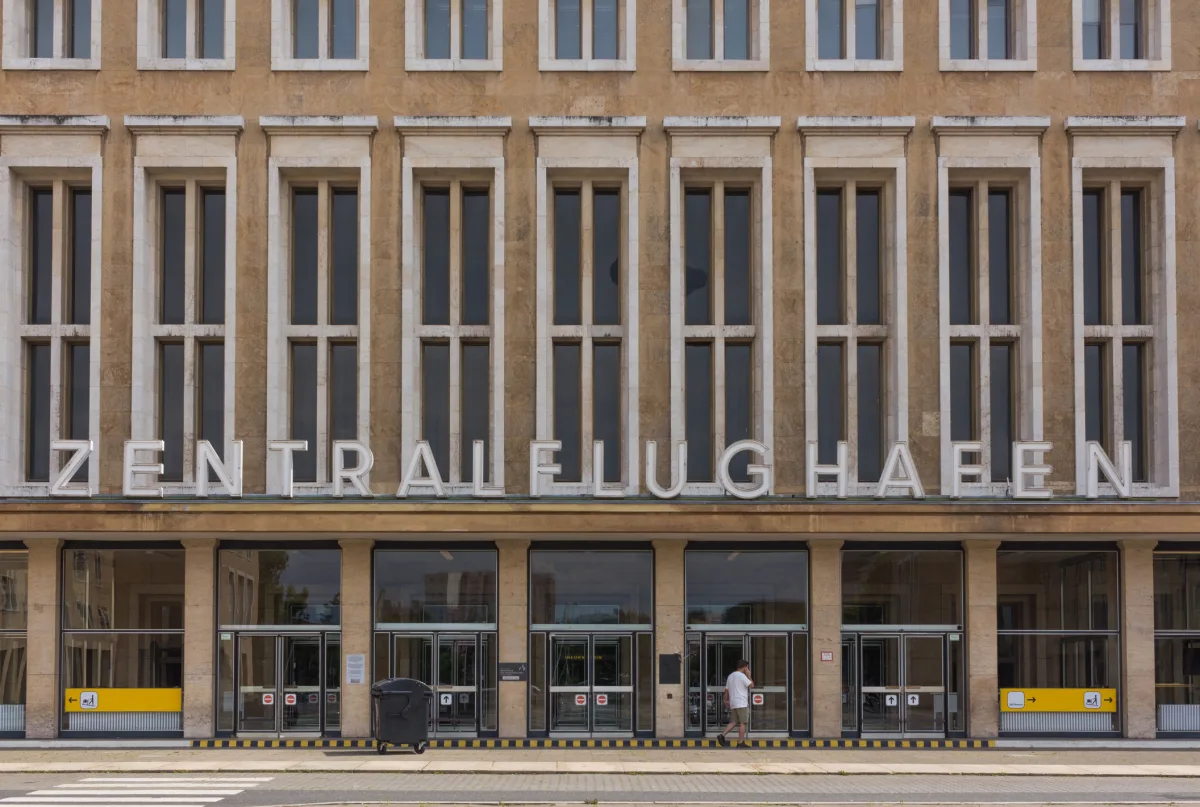A time-travelling passenger wandering through a modern airport terminal might be forgiven for experiencing a strange sense of déjà vu.
Strip away the digital departure boards and racy lingerie adverts, and the fundamental architecture remains stubbornly unchanged from Berlin Tempelhof’s then revolutionary design of the 1930s. The Nazi-era airport, with its sweeping arc terminal and direct aircraft access, established a template that persists nearly a century later: passengers flow from entrance to gate in a linear procession, past shops, restaurants, cafes and bars carefully positioned to extract maximum revenue from their captive audience.
This architectural conservatism might be charming were it not so economically limiting. As the aviation industry prepares for record passenger numbers approaching ten billion in 2025, airports face an uncomfortable truth. While airlines struggle with wafer-thin profit margins, airports themselves could be far more profitable—if only they could escape the gravitational pull of century-old design thinking.
The great profit squeeze
Non-aeronautical revenues account for nearly 40 per cent of total airport income globally, yet revenue per passenger has been declining since 2016, with a compound annual growth rate of -2.3 per cent. This decline occurred even before the Covid-19 pandemic highlighted airports’ dangerous over-reliance on passenger throughput. When borders slammed shut in 2020, retail concessions plummeted by 65.2 per cent, food and beverage by 53.1 per cent, and car parking by 48.9 per cent.
The industry’s response has been predictable: squeeze more revenue from existing models rather than reimagine them entirely. Istanbul Airport, for instance, has embraced artificial intelligence to deliver “highly personalised communication and offers” through its mobile app, while airports worldwide chase the latest customer relationship management fads. Yet for all this digital tinkering, the fundamental passenger experience remains unchanged: arrive, queue, shop, eat and drink under duress, wait, board.
Consider the current roll-call of aviation’s worst offenders. According to AirHelp, which ranks hundreds of airports across the world, at Tunis Carthage just 54 per cent of flights depart on time and is described as, “a hub that doesn’t quite meet the expectations of the modern traveller”. Humberto Delgado in Lisbon meanwhile remains, “a sore spot on many otherwise perfect Portuguese holidays”.
The best airports, by contrast, have recognised that passenger satisfaction and profitability are not opposing forces. Singapore’s Changi Airport—crowned the world’s best for 2025—operates as ‘a destination in itself’, with passengers able to check in 48 hours early and treat the airport as part of their holiday. Its 10-storey Jewel shopping mall attracted 80 million visitors in 2024, many of whom never boarded a plane.

The template breakers
Istanbul Airport, which opened in 2019 and will eventually handle 200 million passengers annually, represents evolution rather than revolution—a supersized version of the traditional model, albeit with Europe’s first triple simultaneous runway operations and impressive innovations including therapy dogs for nervous fliers.
More intriguing perhaps is Poland’s planned Solidarity Transport Hub, part of which might open in 2032. Rather than simply processing airline passengers, the project integrates air, rail, and road transport in a single complex, with high-speed rail connections that will make the airport accessible from most Polish cities in under two and a half hours.
How much of it gets built, however, is a moot point. A pet project of Poland’s previous, nationalist government, the current prime minister, Donald Tusk, suggested last year that the project could be “streamlined” (read: downsized), although he insisted that it would still be “the most modern airport in Europe”.
Whatever the final outcome, the Polish project does represent true innovation in its recognition that airports need not be destinations of last resort. By positioning the facility almost halfway between Warsaw and Łódź and integrating it with national transport networks, the design acknowledges that modern airports must function as genuine urban centres, not merely aviation processing plants.
The revenue revolution
The Singapore example suggests that the path to airport profitability lies not in squeezing more money from harried passengers, but in reconsidering what airports are for.
Non-aeronautical revenue streams—retail, food and beverage, advertising, car rentals, parking, and real estate—offer significant untapped potential. Yet most airports remain trapped in what might be called the ‘duty-free fallacy’: the assumption that captive passengers with time to kill represent an optimal customer base.
Other successful airports have recognised this assumption as flawed. Munich Airport transforms seasonally—its central plaza becomes a surfing arena in summer (complete with artificial waves), hosts Oktoberfest celebrations with authentic beer gardens, and morphs into a Christmas market in December.
Amsterdam’s Schiphol has created spaces that extend passenger dwell time: its library encourages travellers to arrive hours early, massage chairs scattered throughout terminals turn waiting into wellness experiences, and the indoor forest with phone-charging exercise bikes transforms the typically stressful pre-flight period into active relaxation. While these amenities primarily serve passengers, they fundamentally alter the airport’s value proposition from necessary evil to anticipated experience.
London Stansted Airport financed new terminal infrastructure entirely through retail concession revenues, demonstrating how non-aeronautical income can fund capital improvements without burdening airlines with higher charges. This approach becomes increasingly important as airports compete for cost-conscious carriers operating on margins that would make supermarket chains weep.
Digital transformation, analogue problems
Technology has long been viewed as a panacea for airport reinvention. New scanners are rolling out across many airports worldwide, negating the need to take liquids and electronic devices out of hand luggage and reducing security queues accordingly.
Future airports could leverage IoT sensors for real-time luggage tracking, eliminating one of our oldest anxieties. Artificial intelligence and big data could optimise everything from queue management to personalised retail offers. Urban air mobility—flying taxis and eVTOL aircraft—may soon connect airports directly to city centres, potentially reducing the importance of ground access.
Yet technology alone cannot solve airports’ fundamental design problems. Despite investments in ‘smart windows’ and biophilic design elements, most airports remain essentially linear processing facilities—albeit with better lighting and more sophisticated crowd control.
The real opportunity lies in recognising that airports occupy some of the world’s most valuable real estate. Tempelhof Airport now functions as a 1,000-acre public park in the city centre, demonstrating the transformative potential of reimagining these spaces.
Rather than viewing airports as necessary evils to be endured, future designers might consider them as urban assets to be celebrated.
The ideal airport
What would a truly reimagined airport look like? It would begin with recognising that passenger shopping behaviour differs fundamentally from high-street retail—travellers are not leisure shoppers, and treating them as such creates frustration rather than revenue. Instead, the ideal airport would function as a genuine mixed-use development, attracting local residents and businesses alongside passengers.
Imagine an airport where integrated transport connections make it a natural stopping point for non-travellers, where where sustainable initiatives appeal to environmentally conscious consumers. This airport would feature flexible spaces that adapt to demand, innovative flooring materials that reduce noise while facilitating luggage movement, and designs that prioritise passenger wellbeing over architectural grandstanding.
Most importantly, it would abandon the linear passenger flow that has defined airports since Tempelhof. While today’s airports offer cursory differentiation—business-class lounges, priority security lanes, premium check-in counters—these are mere add-ons to a fundamentally uniform system.
A truly reimagined airport would feature entirely separate passenger ecosystems: express routes for time-pressed business travellers bypassing retail entirely, family zones with extended dwell areas and child-friendly amenities, and leisure circuits designed to maximise browsing time for holiday passengers.
Transit passengers, who currently navigate the same overcrowded terminals as final-destination travellers, would access dedicated zones optimised for their brief stopovers. Rather than the current model of forcing all passengers through identical chokepoints, future airports would segment flows from kerb to gate based on passenger behaviour and spending propensity.
The bottom line
The aviation industry faces unprecedented challenges: supply chain disruptions, climate concerns, and the need to accommodate record passenger volumes. However, airports remain stubbornly wedded to designs conceived when passenger jets were a novelty and international travel was the preserve of the wealthy elite.
The global airport design market is projected to reach 28 billion US dollars by 2033, suggesting considerable appetite for innovation. The question is whether this investment will produce genuinely transformative designs or merely more sophisticated versions of the Tempelhof template.
For airports willing to think beyond their aviation origins, the opportunities are substantial. The airport non-aeronautical revenue market is expected to grow from 62.39 US dollars in 2024 to 118.5 by 2032, driven not by extracting more money from reluctant passengers, but by creating spaces that people actively want to visit.
The airports that thrive in the coming decades will be those that reject the assumption that aviation and commerce are distinct activities requiring separate spaces. Instead, they will embrace their role as urban infrastructure, designing experiences that serve their communities as well as their passengers.
The age of the airport as mere departure lounge is ending. The question is what will replace it.
Photo: Dreamstime.







